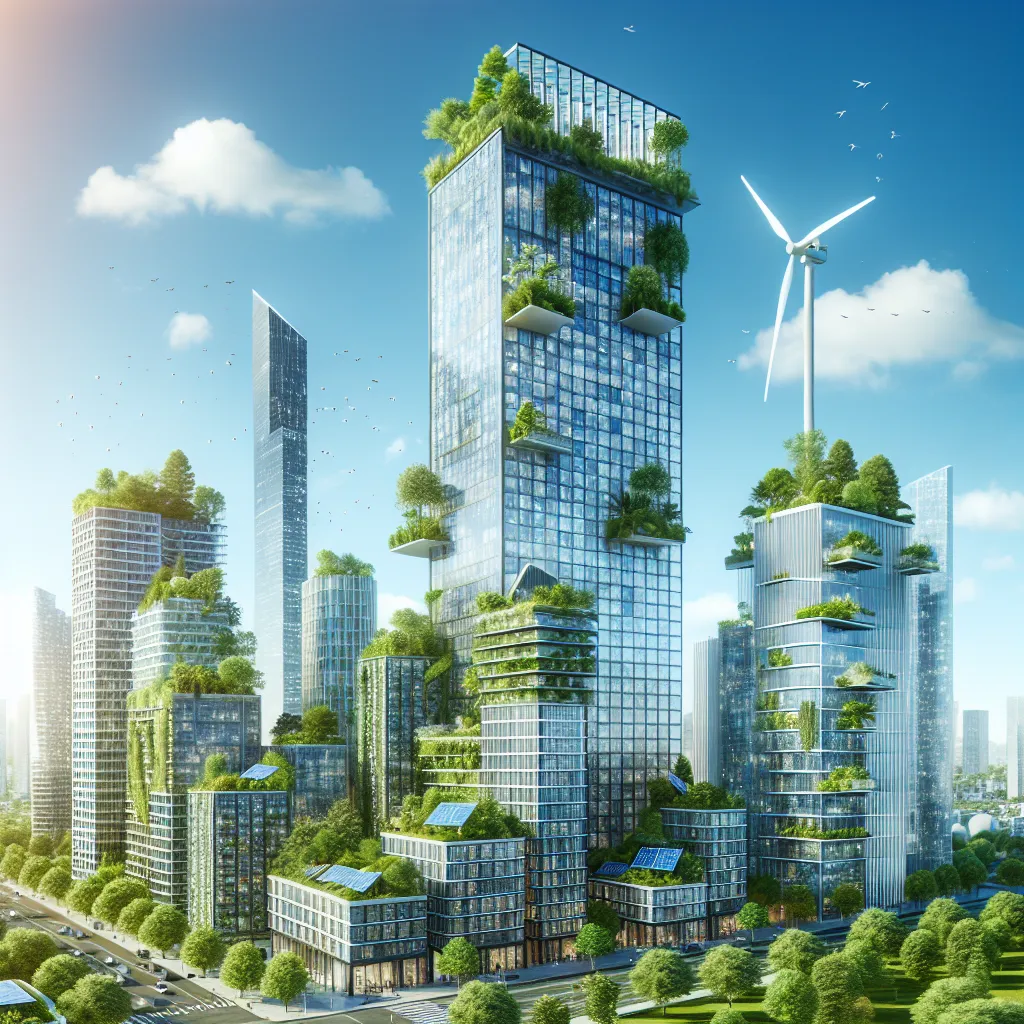What is a LEED certificate and how does it impact sustainable construction?

- How do LEED standards contribute to environmentally friendly construction?
- How does a quality interface contribute to the success of an application?
Eco-efficient design and LEED standards
Eco-oriented design is currently on the rise thanks to highly efficient standards.LEEDLeadership in energy-efficient and environmentally friendly design. These certification rules for buildings, with a focus on their ecological sustainability, emerged in 1998 under the auspices of the U.S. Green Building Council (USGBC). Buildings that receive LEED certification are required to meet strict standards regarding energy-efficient use, rational water resource consumption, and reduction of carbon emissions.
Global spread of LEED standards
As of today, more than 11,000 buildings, with a total area of about 100 square kilometers, have received LEED certification in nearly 100 countries around the world, among which the following stand out:
- U.S.
- Canada
- Russia
- Mexico
- United Kingdom
- Germany
- Brazil
- India
- China
There are about 19,500 organizations and approximately 30,000 professionals operating within the USGBC.
LEED certification criteria
The LEED standard systems encompass a wide range of criteria by which experts from the Green Building Certification Institute (GBCI) evaluate projects and assign points. There are four levels of certification, determined by the total number of points earned:
- Approved (Certified) — from 40 to 49 points;
- Silver (Silver) — 50-59 points;
- Golden (Gold) — 60-79 points;
- Platinum (Platinum) — 80-100 points.
Main areas of certification
The LEED certification process covers six main areas:
- Eco-friendly construction siteSustainable Sites
- Effectiveness of water supplyWater Efficiency
- Energy saving and microclimateEnergy and Atmosphere
- Eco-friendly materialsMaterials and Resources
- Indoor air qualityIndoor Environmental Quality
- Innovations in designInnovation and Design
Significant achievements of LEED
The first LEED Platinum certification was awarded to a commercial building in the state of Maryland. Other properties that have received this status include Adobe's office in California, the Pacific Controls headquarters in Dubai, and the New York Academy of Sciences building.
The benefits of sustainable construction
Successes in sustainable construction help minimize negative impacts on the environment and provide significant resource savings. This is an important step towards preserving the planet for future generations. Initiatives like LEED standards quickly disseminate knowledge and best practices in architecture and construction, shaping a more efficient and eco-friendly approach to the design and operation of buildings.
Conclusion
It can be confidently stated that LEED certification has become a significant milestone on the path to an environmentally friendly future in urban planning and architecture.
Introduction
In the era of modern technology, user interaction with various platforms and services is becoming increasingly relevant. One of the top priorities for such solutions is to create comfortable conditions for interaction. Platforms must not only be highly functional but also user-friendly. This requires the implementation of modern design solutions that simplify navigation and make the process of communicating with the service more intuitive.
Rough distribution of elements
One of the key aspects of quality design is the proper distribution of visual and textual elements. For example, the background design should not distract users from the main information, but at the same time, it should create an appropriate atmosphere. A well-chosen color scheme becomes an important factor—it should be balanced and not cause discomfort to the eyes.
Convenience of data entry
The form of data input is also of significant importance in this context; it should stand out for its convenience and aesthetic appeal. Clearly defined fields for entering information minimize the likelihood of confusion. Rounded edges and sufficient sizes of input fields give the interface a friendly aspect. The font color and size should be chosen in such a way that the text remains easily readable against any background.
Availability of buttons and controls
It is also important to pay attention to the placement of buttons and controls. They should be easily accessible and intuitive for the user. Their significance cannot be overstated, as the speed and efficiency of performing necessary actions depend on it. For example, the submit button should clearly indicate that the action has been successfully completed.
Interaction with the interface
User interaction with interface elements is equally important.
9 October 2024
29 January
29 September
9 October 2024

Principles of accessibility
It is also important to consider accessibility principles. All users, including people with disabilities, should have equal access to all features of the application. Designing with accessibility in mind helps avoid numerous issues in the early stages of development and expands the potential user audience.
Clear notifications
In addition, it is essential to implement clear notifications that will keep the user informed about all important events. Notifications about actions taken or errors should be as simple as possible and should not cause confusion. This ensures that users are always aware of what is happening and can quickly respond to any difficulties that arise.
User needs analysis
The interface design should be based on a detailed analysis of user preferences. A clear understanding of client requests will enable the creation of a truly effective product. Research and surveys will help determine which features are most important for your target audience.
Regular updates
Don't forget about the need for updates. An excellent addition would be for the app's interface to adapt to changes in user needs and new technological conditions. Regular updates not only maintain user interest but also enhance the app's security.
Conclusion
Such a detailed approach to every aspect of interface design not only makes the application more appealing but also positively impacts the brand's reputation. The success of a product in the market largely depends on how comfortable and intuitive the environment feels to the user. This is directly related to how satisfied customers are and how willing they are to recommend your application to friends and acquaintances. Ultimately, a well-thought-out interface can significantly increase the number of users and strengthen loyalty among current customers.

Conclusion
The conclusion I want to draw in this article emphasizes the importance of initiatives for green building, such as the LEED certification system. We live in an era where issues of sustainable development and environmental care are coming to the forefront, and it is crucial for architects and builders to focus on creating buildings that not only look beautiful and serve their functions but also meet high environmental standards.
The LEED system, implemented since 1998, has become a true beacon on the path to responsible construction. More than 11,000 projects around the world have been awarded LEED certification, demonstrating that sustainable approaches are being applied regardless of cultural and economic factors. This fact inspires and convinces us that every step towards eco-friendly construction is significant.
The significance of LEED certification
We can observe how various buildings are being registered — from commercial to residential, and this confirms the fact that the need for environmental protection encompasses all areas of our lives. Considering the different certification categories, everyone can strive for the best:
- “approved”— from 40 to 49 points;
- “silver”— from 50 to 59 points;
- “golden”— from 60 to 79 points;
- “platinum”— from 80 to 100 points.
This fact creates healthy competition among developers.
Examples of successful practices
The very fact that such companies and organizations, likeAdobeand the headquartersPacific ControlsSuccessfully implementing design with LEED principles opens new horizons for others. This is an example of how business can be successful while also serving as a model of responsibility for future generations.
Economic benefits
From an investment perspective, environmentally sustainable buildings can lead to reduced costs for energy and water resources, which is an important factor in today's economy. Looking to the future, I see more and more people and organizations choosing and supporting the principles of eco-friendly design, thereby actively participating in the creation of a balanced and sustainable world.
The philosophy of LEED
LEED is not just a certification; it's a philosophy that changes the approach to construction and ultimately alters our perception of the environment around us.
Comment
Popular Posts
9 October 2024
1484
29 September
321
9 October 2024
9931
Popular Offers

Subscribe to the newsletter from Hatamatata.com!
Subscribe to the newsletter from Hatamatata.com!
I agree to the processing of personal data and confidentiality rules of Hatamatata











